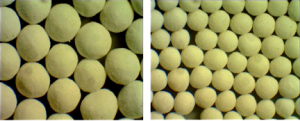Applied Minerals Partners with OPF to Develop Ceramic-Based Proppants for Oil and Gas Drilling Applications
Post Date: 30 Oct 2013 Viewed: 424
Applied Minerals, Inc. (the “Company”, “Applied Minerals”), a leading global producer of halloysite clay and high-grade iron oxide, today announced that it has entered into a development agreement with OPF Enterprises, LLC (“OPF”), a leading ceramic consulting firm that focuses on ceramic materials and process development, to formulate a range of ceramic-based proppants to market to oil and gas drillers in shale formations in close proximity to the Company’s Utah-based Dragon Mine.
Preliminary development work indicates that the presence of both halloysite and other clay minerals found in areas of the Dragon Mine resource produce ceramic proppants with attractive crush strength, permeability and specific gravity characteristics that meet or exceed certain performance metrics of several competing ceramic-based products.
Formulations will primarily utilize alumina-rich clay found both in the mine’s Western Area resource and five surface piles, which possess chemistries very similar to the ceramic proppants currently on the market. The Company’s higher-grade clay resource, located in the Dragon Pit area of the mine, will continue to be used to develop higher value applications such as polymer composites, flame retardants, environmental remediation, controlled release carriers and catalysts.

Applied Minerals is advantageously positioned to capitalize on the attractive growth prospects of the proppant market due to the proximity of its Dragon Mine to the Bakken Shale, a user of approximately $1.0 billion of ceramic proppants per year, the largest in North America. The Bakken region is served primarily by ceramic producers located in Arkansas, Alabama, Georgia and China, against all of which the Dragon Mine has a meaningful logistical advantage.
Applied Minerals and OPF will continue to work on optimizing a range of ceramic-based proppants and identifying a strategic partner with whom to commercialize a ceramic proppant manufacturing operation.
Development of Ceramic Proppants
Proppants are spherical beads designed to keep an induced hydraulic fracture open during the fracturing process (also known as “fracking”) used to access deep oil and gas resources. Ceramic-based proppants have been developed to meet the higher performance requirements needed by unconventional, multi-stage horizontal drilling to hold open shale fractures at increasingly lower depths where significant oil and gas resources exist.
Deep shale drillers utilizing hydraulic fracturing are continually striving to identify ceramic proppants that are lighter, stronger and exhibit superior conductivity and permeability. Increased lightness is needed to ensure the material sufficiently fills the fractures created in the shale, reducing the volume of water and chemicals required; improved strength is required to keep fractures open under the greater pressures experienced at deeper drilling depths; and enhanced porosity is desired to increase the flow of the oil and gas liquids freed through the fracturing of the shale.
As mentioned earlier, development work indicates that the presence of halloysite and its unique tubular morphology within the clay mixtures found in both the Dragon Mine’s Western Area and the five surface piles can be used to develop a range of ceramic proppants that provides the desired specific gravity, strength, conductivity and permeability needed in demanding driller operations such as the Bakken Shale. The range of proppant products will be based on varying ceramic blends drawn primarily from these resources. Different mesh sizes and strengths will address a number of performance and price points.
Ceramic Proppant Market
Drillers in the Bakken formation are some of the heaviest users of ceramic proppants due to the high pressures and temperatures encountered at drilling depths from 8,000 to over 12,000 ft. According to The Freedonia Group, Inc., approximately 5.3 billion lbs. of ceramic proppant were consumed in North America in 2012. Assuming a current average selling price of $0.30 per lb., the value of the market in 2012 was approximately $1.6 billion. The Freedonia Group, Inc. expects North American volume consumption of ceramic proppants to grow at a compounded annual rate of 8.8% from 2012 through 2017.
As seen on the map below, the Dragon Mine’s location in southwestern Utah provides a logistical advantage with respect to supplying both the Bakken formation and the Niobrara shale basin, two heavy users of ceramic-based proppants. With the majority of ceramic proppant suppliers to the Bakken and Niobrara formations located in Arkansas, Alabama, Georgia and China, the Dragon Mine has a meaningful advantage with respect to cost of delivery.
Other Markets
In addition to ceramic proppant applications, OPF has agreed to assist in furthering the development of the Company’s Dragon Mine clay for use in traditional application areas such as technical ceramics, catalysts and supports, and porcelain, which would benefit from the unique structure, high plasticity, and high alumina to silica ratios of the Company’s clay resource.
The Dragon Mine
Since January 2009, under the direction of consulting geologist Ian Wilson, PhD, the Company has invested over $7 million in the geological characterization, quantification and development of the Dragon Mine’s clay resource. The property contains an underground halloysite resource, an underground kaolinite resource, and five clay-bearing surface piles located on the property. Typically, only deposits with high levels of alumina bearing clays (a minimum of ~25% alumina content) can be used to make ceramic-based proppants that meet the demanding requirements of deep drillers.
The Company expects the Western Area and the five surface piles of the Dragon Mine to be the primary sources of clay from which proppant material will be formulated. The Western Area of the Dragon Mine includes 862,000 tons of clay consisting primarily of high alumina kaolinite with a presence of halloysite, gibbsite, alunite, as well as hematite, an effective fluxing agent utilized in the production of proppants. The property’s five surface piles contain 4.5 million gross tons of clay and iron-bearing material that, upon refining, is believed to be suitable for ceramic proppant production.



